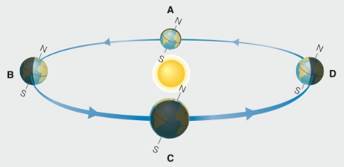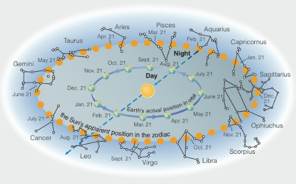
EBK THE COSMIC PERSPECTIVE
9th Edition
ISBN: 9780135161760
Author: Voit
Publisher: VST
expand_more
expand_more
format_list_bulleted
Textbook Question
Chapter 2, Problem 4VSC
Use the following questions to check your understanding of some of the many types of visual information used in astronomy. For additional practice, try the Chapter 2 Visual Quiz at MasteringAstronomy®.

The figure above is a typical diagram used to describe Earth's seasons.

The figure above (based on Figure 2.14) shows the Sun’s path through the constellations of the zodiac.
4. The diagram exaggerates the sizes of Earth and the Sun relative to the orbit. lf Earth were correctly scaled relative to the orbit in the figure, how big would it be?
a. about half the size shown
b. about 2 millimeters across
c. about 0.1 millimeter across
d. microscopic
Expert Solution & Answer
Want to see the full answer?
Check out a sample textbook solution
Students have asked these similar questions
You are standing a distance x = 1.75 m away from this mirror. The object you are looking at is y = 0.29 m from the mirror. The angle of incidence is θ = 30°. What is the exact distance from you to the image?
For each of the actions depicted below, a magnet and/or metal loop moves with velocity v→ (v→ is constant and has the same magnitude in all parts). Determine whether a current is induced in the metal loop. If so, indicate the direction of the current in the loop, either clockwise or counterclockwise when seen from the right of the loop. The axis of the magnet is lined up with the center of the loop. For the action depicted in (Figure 5), indicate the direction of the induced current in the loop (clockwise, counterclockwise or zero, when seen from the right of the loop). I know that the current is clockwise, I just dont understand why. Please fully explain why it's clockwise, Thank you
A planar double pendulum consists of two point masses \[m_1 = 1.00~\mathrm{kg}, \qquad m_2 = 1.00~\mathrm{kg}\]connected by massless, rigid rods of lengths \[L_1 = 1.00~\mathrm{m}, \qquad L_2 = 1.20~\mathrm{m}.\]The upper rod is hinged to a fixed pivot; gravity acts vertically downward with\[g = 9.81~\mathrm{m\,s^{-2}}.\]Define the generalized coordinates \(\theta_1,\theta_2\) as the angles each rod makes with thedownward vertical (positive anticlockwise, measured in radians unless stated otherwise).At \(t=0\) the system is released from rest with \[\theta_1(0)=120^{\circ}, \qquad\theta_2(0)=-10^{\circ}, \qquad\dot{\theta}_1(0)=\dot{\theta}_2(0)=0 .\]Using the exact nonlinear equations of motion (no small-angle or planar-pendulumapproximations) and assuming the rods never stretch or slip, determine the angle\(\theta_2\) at the instant\[t = 10.0~\mathrm{s}.\]Give the result in degrees, in the interval \((-180^{\circ},180^{\circ}]\).
Chapter 2 Solutions
EBK THE COSMIC PERSPECTIVE
Ch. 2 - Prob. 1VSCCh. 2 - Use the following questions to check your...Ch. 2 - Use the following questions to check your...Ch. 2 - Use the following questions to check your...Ch. 2 - Use the following questions to check your...Ch. 2 - Use the following questions to check your...Ch. 2 - Use the following questions to check your...Ch. 2 - Use the following questions to check your...Ch. 2 - Prob. 1EAPCh. 2 - Suppose you were making a model of the celestial...
Ch. 2 - On a clear, dark night, the sky may appear to be...Ch. 2 - Why does the local sky look like a dome? Define...Ch. 2 - Prob. 5EAPCh. 2 - What are circumpolar stars? Are more stars...Ch. 2 - What are latitude and longitude? Does the sky vary...Ch. 2 - What is the zodiac, and why do we see different...Ch. 2 - Suppose Earth’s axis had no tilt. Would we still...Ch. 2 - Briefly describe key facts about the solstices and...Ch. 2 - What is precession? How does it affect what we see...Ch. 2 - Briefly describe the Moon’s cycle of phases. Can...Ch. 2 - Why do we always see the same face of the Moon?Ch. 2 - Why don’t we see an eclipse at every new and full...Ch. 2 - What do we mean by the apparent retrograde motion...Ch. 2 - Prob. 16EAPCh. 2 - Prob. 17EAPCh. 2 - Prob. 18EAPCh. 2 - Prob. 19EAPCh. 2 - Prob. 20EAPCh. 2 - Does It Make Sense? Decide whether the statement...Ch. 2 - Does It Make Sense? Decide whether the statement...Ch. 2 - Prob. 23EAPCh. 2 - Does It Make Sense? Decide whether the statement...Ch. 2 - Does It Make Sense? Decide whether the statement...Ch. 2 - Does It Make Sense? Decide whether the statement...Ch. 2 - Quick Quiz Choose the best answer to each of the...Ch. 2 - Quick Quiz Choose the best answer to each of the...Ch. 2 - Quick Quiz Choose the best answer to each of the...Ch. 2 - Prob. 30EAPCh. 2 - Quick Quiz Choose the best answer to each of the...Ch. 2 - Quick Quiz Choose the best answer to each of the...Ch. 2 - Quick Quiz Choose the best answer to each of the...Ch. 2 - Quick Quiz Choose the best answer to each of the...Ch. 2 - Quick Quiz Choose the best answer to each of the...Ch. 2 - Quick Quiz Choose the best answer to each of the...Ch. 2 - Earth-Centered or Sun-Centered? Decide whether...Ch. 2 - Shadow Phases. Many people incorrectly guess that...Ch. 2 - Earth-Centered Language. Many common phrases...Ch. 2 - Group Activity: Lunar Phases and Time of Day. Make...Ch. 2 - New Planet. A planet in another solar system has a...Ch. 2 - Your View of the Sky. a. What are your latitude...Ch. 2 - View from the Moon. Assume you live on the Moon,...Ch. 2 - View from the Sun. Suppose you lived on the Sun...Ch. 2 - A Farther Moon. Suppose the distance to the Moon...Ch. 2 - A Smaller Earth. Suppose Earth were smaller. Would...Ch. 2 - Observing Planetary Motion. Find out which planets...Ch. 2 - 47. A Connecticut Yankee. Find the book A...Ch. 2 - Be sure to show all calculations clearly and state...Ch. 2 - Be sure to show all calculations clearly and state...Ch. 2 - Be sure to show all calculations clearly and state...Ch. 2 - Be sure to show all calculations clearly and state...Ch. 2 - Prob. 57EAPCh. 2 - Prob. 58EAPCh. 2 - Be sure to show all calculations clearly and state...
Knowledge Booster
Learn more about
Need a deep-dive on the concept behind this application? Look no further. Learn more about this topic, physics and related others by exploring similar questions and additional content below.Similar questions
- What are the expected readings of the ammeter and voltmeter for the circuit in the figure below? (R = 5.60 Ω, ΔV = 6.30 V) ammeter I =arrow_forwardsimple diagram to illustrate the setup for each law- coulombs law and biot savart lawarrow_forwardA circular coil with 100 turns and a radius of 0.05 m is placed in a magnetic field that changes at auniform rate from 0.2 T to 0.8 T in 0.1 seconds. The plane of the coil is perpendicular to the field.• Calculate the induced electric field in the coil.• Calculate the current density in the coil given its conductivity σ.arrow_forward
- An L-C circuit has an inductance of 0.410 H and a capacitance of 0.250 nF . During the current oscillations, the maximum current in the inductor is 1.80 A . What is the maximum energy Emax stored in the capacitor at any time during the current oscillations? How many times per second does the capacitor contain the amount of energy found in part A? Please show all steps.arrow_forwardA long, straight wire carries a current of 10 A along what we’ll define to the be x-axis. A square loopin the x-y plane with side length 0.1 m is placed near the wire such that its closest side is parallel tothe wire and 0.05 m away.• Calculate the magnetic flux through the loop using Ampere’s law.arrow_forwardDescribe the motion of a charged particle entering a uniform magnetic field at an angle to the fieldlines. Include a diagram showing the velocity vector, magnetic field lines, and the path of the particle.arrow_forward
- Discuss the differences between the Biot-Savart law and Coulomb’s law in terms of their applicationsand the physical quantities they describe.arrow_forwardExplain why Ampere’s law can be used to find the magnetic field inside a solenoid but not outside.arrow_forward3. An Atwood machine consists of two masses, mA and m B, which are connected by an inelastic cord of negligible mass that passes over a pulley. If the pulley has radius RO and moment of inertia I about its axle, determine the acceleration of the masses mA and m B, and compare to the situation where the moment of inertia of the pulley is ignored. Ignore friction at the axle O. Use angular momentum and torque in this solutionarrow_forward
- A 0.850-m-long metal bar is pulled to the right at a steady 5.0 m/s perpendicular to a uniform, 0.650-T magnetic field. The bar rides on parallel metal rails connected through a 25-Ω, resistor (Figure 1), so the apparatus makes a complete circuit. Ignore the resistance of the bar and the rails. Please explain how to find the direction of the induced current.arrow_forwardFor each of the actions depicted, determine the direction (right, left, or zero) of the current induced to flow through the resistor in the circuit containing the secondary coil. The coils are wrapped around a plastic core. Immediately after the switch is closed, as shown in the figure, (Figure 1) in which direction does the current flow through the resistor? If the switch is then opened, as shown in the figure, in which direction does the current flow through the resistor? I have the answers to the question, but would like to understand the logic behind the answers. Please show steps.arrow_forwardWhen violet light of wavelength 415 nm falls on a single slit, it creates a central diffraction peak that is 8.60 cm wide on a screen that is 2.80 m away. Part A How wide is the slit? ΟΙ ΑΣΦ ? D= 2.7.10-8 Submit Previous Answers Request Answer × Incorrect; Try Again; 8 attempts remaining marrow_forward
arrow_back_ios
SEE MORE QUESTIONS
arrow_forward_ios
Recommended textbooks for you
 Foundations of Astronomy (MindTap Course List)PhysicsISBN:9781337399920Author:Michael A. Seeds, Dana BackmanPublisher:Cengage Learning
Foundations of Astronomy (MindTap Course List)PhysicsISBN:9781337399920Author:Michael A. Seeds, Dana BackmanPublisher:Cengage Learning Stars and Galaxies (MindTap Course List)PhysicsISBN:9781337399944Author:Michael A. SeedsPublisher:Cengage Learning
Stars and Galaxies (MindTap Course List)PhysicsISBN:9781337399944Author:Michael A. SeedsPublisher:Cengage Learning
 Horizons: Exploring the Universe (MindTap Course ...PhysicsISBN:9781305960961Author:Michael A. Seeds, Dana BackmanPublisher:Cengage Learning
Horizons: Exploring the Universe (MindTap Course ...PhysicsISBN:9781305960961Author:Michael A. Seeds, Dana BackmanPublisher:Cengage Learning AstronomyPhysicsISBN:9781938168284Author:Andrew Fraknoi; David Morrison; Sidney C. WolffPublisher:OpenStax
AstronomyPhysicsISBN:9781938168284Author:Andrew Fraknoi; David Morrison; Sidney C. WolffPublisher:OpenStax An Introduction to Physical SciencePhysicsISBN:9781305079137Author:James Shipman, Jerry D. Wilson, Charles A. Higgins, Omar TorresPublisher:Cengage Learning
An Introduction to Physical SciencePhysicsISBN:9781305079137Author:James Shipman, Jerry D. Wilson, Charles A. Higgins, Omar TorresPublisher:Cengage Learning

Foundations of Astronomy (MindTap Course List)
Physics
ISBN:9781337399920
Author:Michael A. Seeds, Dana Backman
Publisher:Cengage Learning

Stars and Galaxies (MindTap Course List)
Physics
ISBN:9781337399944
Author:Michael A. Seeds
Publisher:Cengage Learning


Horizons: Exploring the Universe (MindTap Course ...
Physics
ISBN:9781305960961
Author:Michael A. Seeds, Dana Backman
Publisher:Cengage Learning

Astronomy
Physics
ISBN:9781938168284
Author:Andrew Fraknoi; David Morrison; Sidney C. Wolff
Publisher:OpenStax

An Introduction to Physical Science
Physics
ISBN:9781305079137
Author:James Shipman, Jerry D. Wilson, Charles A. Higgins, Omar Torres
Publisher:Cengage Learning
Time Dilation - Einstein's Theory Of Relativity Explained!; Author: Science ABC;https://www.youtube.com/watch?v=yuD34tEpRFw;License: Standard YouTube License, CC-BY